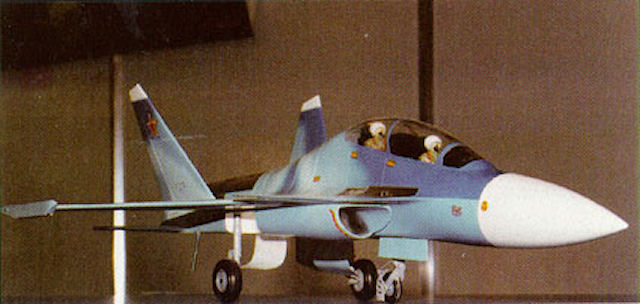selvan33
FULL MEMBER

- Joined
- Nov 10, 2012
- Messages
- 1,267
- Reaction score
- 0
- Country
- Location
Blast from the Past: Sukhoi and its offer for MMRCA

When IAF issued Request for Information (RFI) in 2001 for MMRCA tender, IAF in MMRCA tender was looking for an aircraft in medium class category , IAF had initially had planned to purchase 126 Mirage 2000-5s to equip seven squadrons but later deal was opened to other players to avoid single vendor deal.
Sukhoi Bureau sensing opportunity to sell more fighters after successfully completing MKI project for India , had proposed to India development of S-55 fighter based on Su-27 aerodynamics powered by single example of the Saturn AL-31 TVC engine instead of two, S-55 could have been scaled down accordingly to a smaller layout.
Sukhoi Bureau had done research work on S-55 in 90s but after collapse of Soviet Union no single prototype was developed and project was in cold storage, Proposed S-55 was supposed to borrow heavily from Sukhoi 30 MKI in avionics and design, Sukhoi had kept radar nose cone diameter similar to Su-30, which could have allowed it to carry same radar as MKI.
S-55 aerodynamic configuration resembled that of the Su-33 fighter the Su-30, But India refused to consider a further derivatives of Sukhoi Su-30 for MMRCA and also rejected initial proposal of a Joint venture on S-55, so No RFI or RFP was sent to Sukhoi Bureau. S-55 by many was considered paper plane and no serious thought about it was ever given to it, although RFI and RFP was sent to almost all companies barring Chinese companies, Sukhoi was also kept out of this process . India eventually allowed Gripen NG Demo and Mig-35 aircrafts which were not fully developed to participate in MMRCA trails; Sukhoi was interested in development of S-55 prototype if IAF had send out RFI and RFP for MMRCA requirements to them but that never happened. 10 years down the line MMRCA deal is yet to be signed .
S-55/56 17.5 meters long
spread 11.7 m
height 5.1 m
wing area 49.2 sq. m. (40 sq. m.)
weight maximum 15000 kgf
normal 11250 kgf
empty 8000 kgf
fuel 4500 kgf
load 3000 kgf
speed max 2100 km/h
speed cruise 1400 km/h
service ceiling 59,000ft
range 510 miles on internal fuel at low level, 1,810 miles at height
distance 4000 km
engine AL-31F 12500 kG. AL-41F1 15500 kG.
Blast from the Past: Sukhoi and its offer for MMRCA | idrw.org

When IAF issued Request for Information (RFI) in 2001 for MMRCA tender, IAF in MMRCA tender was looking for an aircraft in medium class category , IAF had initially had planned to purchase 126 Mirage 2000-5s to equip seven squadrons but later deal was opened to other players to avoid single vendor deal.
Sukhoi Bureau sensing opportunity to sell more fighters after successfully completing MKI project for India , had proposed to India development of S-55 fighter based on Su-27 aerodynamics powered by single example of the Saturn AL-31 TVC engine instead of two, S-55 could have been scaled down accordingly to a smaller layout.
Sukhoi Bureau had done research work on S-55 in 90s but after collapse of Soviet Union no single prototype was developed and project was in cold storage, Proposed S-55 was supposed to borrow heavily from Sukhoi 30 MKI in avionics and design, Sukhoi had kept radar nose cone diameter similar to Su-30, which could have allowed it to carry same radar as MKI.
S-55 aerodynamic configuration resembled that of the Su-33 fighter the Su-30, But India refused to consider a further derivatives of Sukhoi Su-30 for MMRCA and also rejected initial proposal of a Joint venture on S-55, so No RFI or RFP was sent to Sukhoi Bureau. S-55 by many was considered paper plane and no serious thought about it was ever given to it, although RFI and RFP was sent to almost all companies barring Chinese companies, Sukhoi was also kept out of this process . India eventually allowed Gripen NG Demo and Mig-35 aircrafts which were not fully developed to participate in MMRCA trails; Sukhoi was interested in development of S-55 prototype if IAF had send out RFI and RFP for MMRCA requirements to them but that never happened. 10 years down the line MMRCA deal is yet to be signed .
S-55/56 17.5 meters long
spread 11.7 m
height 5.1 m
wing area 49.2 sq. m. (40 sq. m.)
weight maximum 15000 kgf
normal 11250 kgf
empty 8000 kgf
fuel 4500 kgf
load 3000 kgf
speed max 2100 km/h
speed cruise 1400 km/h
service ceiling 59,000ft
range 510 miles on internal fuel at low level, 1,810 miles at height
distance 4000 km
engine AL-31F 12500 kG. AL-41F1 15500 kG.
Blast from the Past: Sukhoi and its offer for MMRCA | idrw.org




